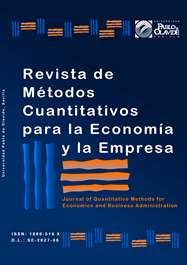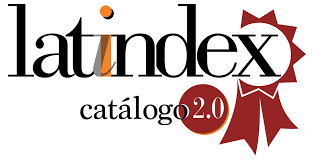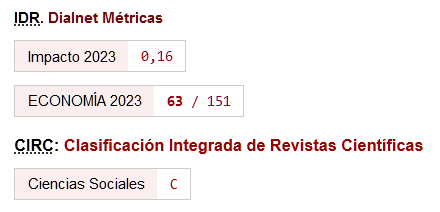Relationship between Productivity and Efficiency with Sustainable Development Goals: the Case of the Manufacturing Industry in Pichincha, Ecuador
DOI:
https://doi.org/10.46661/revmetodoscuanteconempresa.5475Keywords:
data envelopment analysis, efficiency, forecast, manufacturing industry, productivity, sustainable development goalsAbstract
In 2015, at the United Nations forum, the 17 Sustainable Development Goals (SDGs) were approved to be met by 2030. This research aims to know what has been the behavior of productivity and efficiency of the manufacturing industry in the province of Pichincha, Ecuador, and the relationship with the achievement of some goals of the SDG 8, 9 and 12. The research methodology has a quantitative, non-experimental, and longitudinal approach. The information from the economic and financial reports of the manufacturing companies between 2010 and 2018 was processed. The values of efficiency were estimated using the data enveloping analysis technique. With the annual information, the evolution of productivity and efficiency was predicted until 2022. In the nine years, the results show that the productivity indicators and the number of companies that are related to goals 8.2 and 8.3 depend on the size of the companies and would maintain a constant trend until 2022. In addition, in the same period, it was shown that efficiency has had variations, and its trend is to remain constant until 2022, which shows that there will be no progress in meeting the targets 9.4, and 12.2 of the SDGs for this industrial sector.
Downloads
References
Ali, S., Hussain, T., Zhang, G., Nurunnabi, M., & Li, B. (2018). The Implementation of Sustainable Development Goals in “BRICS” Countries. Sustainability (Switzerland), 10(7), 1-14. https://doi.org/10.3390/su10072513
Álvarez, A. (2013). La medición de la eficiencia y la productividad (Measuring efficiency and productivity) (1st ed.). Ediciones Pirámides.
Andersen, P., & Petersen, N. C. (1993). A Procedure for Ranking Efficient Units in Data Envelopment Analysis. Management Science, 39(10), 1261-1264. https://doi.org/10.1287/mnsc.39.10.1261
Andersen, P. (2018). Sustainable Operations Management (SOM) Strategy and Management: An Introduction to Part I. In L. Boer & P. Andersen (Eds.), Operations Management and Sustainability: New Research Perspectives (pp. 15-26). Palgrave Macmillan. https://doi.org/10.1007/978-3-319-93212-5_2
Betti, G., Consolandi, C., & Eccles, R. G. (2018). The relationship between investor materiality and the sustainable development goals: A methodological framework. Sustainability (Switzerland), 10(7), 2248. https://doi.org/10.3390/su10072248
Cáceres, H., Kristjanpoller, W., & Tabilo, J. (2014). Análisis de la eficiencia técnica y su relación con los resultados de la evaluación de desempeño en una Universidad chilena (Analysis of technical efficiency and its relationship with the results of the performance evaluation in a Chilean University). Innovar, 24(54), 199-217. https://doi.org/10.15446/innovar.v24n54.46720
Cachanosky, I. (2012). Eficiencia técnica, eficiencia económica y eficiencia dinámica. Procesos de Mercado: Revista Europea de Economía Política, IX(2), 51-80. https://doi.org/10.52195/pm.v9i2.224
Castells, M. (1996). La era de la informacion (The age of information). Economia Sociedad y Cultura, 1, 1-29.
Central Bank of Ecuador (2020). El covid-19 pasa factura a la economía ecuatoriana: decrecerá entre 7,3% y 9,6% en 2020 (COVID-19 takes its toll on the Ecuadorian economy: it will decrease between 7.3% and 9.6% in 2020). Central Bank of Ecuador. https://www.bce.fin.ec/index.php/boletines-de-prensa-archivo/item/1366-el-covid-19-pasa-factura-a-la-economia-ecuatoriana-decrecera-entre-73-y-96-en-2020
Chai, T., & Draxler, R. (2014). Root mean square error (RMSE) or mean absolute error (MAE)? -Arguments against avoiding RMSE in the literature. Geoscientific Model Development, 7(3), 1247-1250. https://doi.org/10.5194/gmd-7-1247-2014
Charnes, A., Cooper, W.W., & Rhodes, E. (1979). Measuring the efficiency of decision-making units. European Journal of Operational Research, 3(4), 339. https://doi.org/10.1016/0377-2217(79)90229-7
Cook, W., & Seiford, L. (2009). Data envelopment analysis ( DEA ) – Thirty years on. European Journal of Operational Research, 192, 1-17. https://doi.org/10.1016/j.ejor.2008.01.032
Cooper, W., Seiford, L.M., & Zhu, J. (2011). Data Envelopment Analysis: History, Models, and Interpretations. In Handbook on Data Envelopment Analysis (2nd ed., Vol. 164, pp. 1-40). Springer. https://doi.org/10.1007/978-1-4419-6151-8
Cordero, J.M. (2006). Evaluación de la eficiencia con factores exógenos mediante el análisis envolvente de datos. una aplicación a la educación secundaria en España [Universidad de extremadura]. http://dialnet.unirioja.es/servlet/tesis?codigo=1488
Cordova, M.F., & Celone, A. (2019). SDGs and Innovation in the Business Context Literature Review. Sustainability (Switzerland), 11(24), 1-14. https://doi.org/10.3390/su11247043
De Oliveira, G.C., Ferreira, J.M., Silva, P.C., de Oliveira, A.G., & Lucato, W.C. (2019). Cleaner Production in the textile industry and its relationship to sustainable development goals. Journal of Cleaner Production, 228, 1514-1525. https://doi.org/10.1016/j.jclepro.2019.04.334
Delgado, M., & Delgado, M. (2020). Sustainable Development Goal 12 and Its Relationship with the Textile Industry. In M. A. Gardetti & S. Senthilkannan Muthu (Eds.), The UN Sustainable Development Goals for the Textile and Fashion Industry (pp. 21-46). Springer. https://doi.org/10.1007/978-981-13-8787-6_2
ECLAC (2020a). Alicia Bárcena Calls for Rethinking the Model and Consolidating the Economic, Social and Environmental Dimensions of Sustainable Development so as to Leave No One Behind. Economic Commission for Latin America and the Caribbean. https://www.cepal.org/en/pressreleases/alicia-barcena-calls-rethinking-model-and-consolidating-economic-social-and
ECLAC (2020b). Latin America and the Caribbean and the COVID-19 pandemic. Economic and social effects. In Economic Commission for Latin America and the Caribbean (Issue 1). https://repositorio.cepal.org/bitstream/handle/11362/45351/S2000263_en.pdf?sequence=4&isAllowed=y
ECLAC (2020c). Report on the economic impact of coronavirus disease ( COVID-19 ) on Latin America and the Caribbean. In Economic Commission for Latin America and the Caribbean (Issue March). https://repositorio.cepal.org/bitstream/handle/11362/45603/1/S2000312_en.pdf
Eustachio, J.H.P.P., Caldana, A.C.F., Liboni, L.B., & Martinelli, D.P. (2019). Systemic indicator of sustainable development: Proposal and application of a framework. Journal of Cleaner Production, 241. https://doi.org/10.1016/j.jclepro.2019.118383
Färe, R., Grosskopf, S., Lovell, C. A. K., & Pasurka, C. (1989). Multilateral productivity comparisons when some outputs are undesirable: A nonparametric approach. Review of Economics and Statistics, 71(1), 90-98. https://doi.org/10.2307/1928055
Färe, R., Grosskopf, S., Norris, M., & Zhang, Z. (1994). Productivity growth, technical progress and efficiency Change in Industrialized Countries. The American Economic Review, 84(1), 66-83. https://doi.org/10.1111/j.1467-8268.2004.00089.x
Farrell, M. (1957). The measurement of productive efficiency. Journal of the Royal Statistical Society, 120, 253-290. https://doi.org/10.2307/2343100
Farzipoor, R. (2010). Developing a new data envelopment analysis methodology for supplier selection in the presence of both undesirable outputs and imprecise data. International Journal of Advanced Manufacturing Technology, 51(9-12), 1243-1250. https://doi.org/10.1007/s00170-010-2694-3
González-Araya, M., & Valdés, N. (2009). Metodo de selección de variables para mejorar la discriminación en el análisis de eficiencia aplicando modelos DEA. Ingeniería Industrial, 2(8), 45-56.
Griggs, D., Stafford-Smith, M., Gaffney, O., Rockström, J., Öhman, M.C., Shyamsundar, P., Steffen, W., Glaser, G., Kanie, N., & Noble, I. (2013). Sustainable development goals for people and planet. Nature, 495(7441), 305-307. https://doi.org/10.1038/495305a
Guerrero, V. (2003). Análisis estadístico de series de tiempo económicas (Statistical analysis of economic time series) (2nd ed.). International Thomson Editores.
Hák, T., Janoušková, S., & Moldan, B. (2016). Sustainable Development Goals: A need for relevant indicators. Ecological Indicators, 60, 565-573. https://doi.org/10.1016/j.ecolind.2015.08.003
Harrison, W., Horngren, C., Thomas, W., Tietz, W., Berberich, G., & Seguin, C. (2018). Financial Accounting (6th ed.). Pearson.
Ibujés-Villacís, J. (2019). La eficiencia técnica de las medianas empresas de manufactura de Quito. Debates Sobre Innovación. XVIII Congreso Latinoamericano de Gestión Tecnológica, 3(1), 1126-1141. https://economiaeinnovacionuamx.org/revista/secciones/articulos/7
Ibujés-Villacís, J., & Franco-Crespo, A. A. (2019). Use of ICT and its relationship with the Objectives of Sustainable Development in Ecuador. RETOS. Revista de Ciencias de la Administración y Economía, 9(17), 37-53. https://doi.org/10.17163/ret.n17.2019.03
Ibujés-Villacís, J., & Morales, E. (2018). Uso de las TIC y relación con la eficiencia técnica en las medianas empresas del área comercial de Quito. XIV Foro Internacional Del Emprendedor, 166-182. http://revistas.uazuay.edu.ec/index.php/memorias/article/view/185
Ibujés, J., & Benavides, M. (2017). Contribution of technology to the productivity of small and medium-sized enterprises in the textile industry in Ecuador. Cuadernos de Economia, 41(115), 140-150. https://doi.org/10.1016/j.cesjef.2017.05.002
Ike, M., Donovan, J. D., Topple, C., & Masli, E. K. (2019). The process of selecting and prioritising corporate sustainability issues: Insights for achieving the Sustainable Development Goals. Journal of Cleaner Production, 236, 117661. https://doi.org/10.1016/j.jclepro.2019.117661
INEC (2012). CIIU 4.0. Clasificación Nacional de Actividades Económicas (p. 234). INEC. https://aplicaciones2.ecuadorencifras.gob.ec/SIN/descargas/ciiu.pdf
INEC (2019a). Encuesta a Empresas. Encuesta Estructural Empresarial. In Instituto Nacional de Estadísticas y Censos. http://www.ecuadorencifras.gob.ec/encuesta-a-empresas/
INEC (2019b). Encuesta nacional de empleo, desempleo y subempleo. In Instituto Nacional de Estadísticas y Censos. https://www.ecuadorencifras.gob.ec/documentos/web-inec/EMPLEO/2019/Junio/201906_Mercado_Laboral_final.pdf
International Monetary Fund (2020). World Economic Outlook. Chapter 1: The Great Lockdown. IMF. https://www.imf.org/en/Publications/WEO/Issues/2020/04/14/weo-april-2020
Lafortune, G., Fuller, G., Schmidt-Traub, G., & Kroll, C. (2020). How Is Progress towards the Sustainable Development Goals Measured ? Comparing Four Approaches for the EU. Sustainability (Switzerland), 12(18), 1-24. https://doi.org/10.3390/su12187675
Lakshmivarahan, S., Lewis, J. M., & Jabrzemski, R. (2017). Forecast Error Correction using Dynamic Data Assimilation (Springer (ed.); 1st ed.). https://doi.org/10.1007/978-3-319-39997-3
Lind, D., Marchal, W., & Wathen, S. (2012). Estadística aplicada a los negocios y la economía (Statistics applied to business and economy) (McGraw-Hill (ed.); 15th ed.).
Lohr, S.L. (2019). Simple Probability Samples. In Sampling. Design and Analysis (2nd ed., pp. 25–72). CRC Press. https://doi.org/10.1201/9780429296284-2
Martins, V.W.B., Rampasso, I.S., Siltori, P.F.S., Cazeri, G.T., Anholon, R., Quelhas, O.L.G., & Leal, W. (2020). Contributions from the Brazilian industrial sector to sustainable development. Journal of Cleaner Production, 272, 1-25. https://doi.org/10.1016/j.jclepro.2020.122762
Navarrete, S.D.S., Borini, F.M., & Avrichir, I. (2020). Environmental upgrading and the United Nations Sustainable Development Goals. Journal of Cleaner Production, 264, 121563. https://doi.org/10.1016/j.jclepro.2020.121563
Nilsson, M., Chisholm, E., Griggs, D., Howden-Chapman, P., McCollum, D., Messerli, P., Neumann, B., Stevance, A. S., Visbeck, M., & Stafford-Smith, M. (2018). Mapping interactions between the sustainable development goals: lessons learned and ways forward. Sustainability Science, 13(6), 1489-1503. https://doi.org/10.1007/s11625-018-0604-z
Ott, R.L., & Longnecker, M. (2016). Inferences About Population Central Values. In An Introduction to Statistical Methods & Data Analysis (Seventh, pp. 232-299). Cengage Learning.
Paradi, J.C., Sherman, H.D., & Tam, F.K. (2018). Data Envelopment Analysis in the Financial Services Industry. Springer. https://doi.org/10.1007/978-3-319-69725-3
Pérez, C. (2010). Técnicas de muestreo estadístico (Statistical sampling techniques) (I. Publicaciones (ed.); 1.a). Ibergarceta Publicaciones.
Pizzi, S., Caputo, A., Corvino, A., & Venturelli, A. (2020). Management research and the UN sustainable development goals (SDGs): A bibliometric investigation and systematic review. Journal of Cleaner Production, 276, 124033. https://doi.org/10.1016/j.jclepro.2020.124033
Quindós, M. del P., Rubiera, F., & Vicente, M. R. (2003). Análisis envolvente de datos: una aplicación al sector de los servicios avanzados a las empresas del Principado de Asturias). Rect@, 11(1), 21.
Ramanathan, R. (2003). An introduction to Data Envelopment Analysis. In SAGE Publications (1st ed.). Sage Publications, Inc.
Sánchez de Pedro, E. A. (2013). Nivel de competitividad y eficiencia de la producción ganadera (Level of competitiveness and efficiency of livestock production) [Universidad de Córdoba]. https://helvia.uco.es/xmlui/handle/10396/10498
Santos, J., Negas, E., & Cavique, L. (2013). Introduction to Data Envelopment Analysis. In Efficiency Measures in the Agricultural Sector (1st ed., Issue January, p. 16). Springer. https://doi.org/10.1007/978-94-007-5739-4
SENESCYT-INEC (2015). Principales indicadores de actividades de ciencia, tecnología e innovación. In Secretaría de Educación Superior, Ciencia, Tecnología e Innovación. http://www.ecuadorencifras.gob.ec/documentos/web-inec/Estadisticas_Economicas/Ciencia_Tecnologia/Presentacion_de_principales_resultados_ACTI.pdf
Serrano-Cinca, C., Fuertes-Callén, Y., & Mar-Molinero, C. (2005). Measuring DEA efficiency in Internet companies. Decision Support Systems, 38, 557-573. https://doi.org/10.1016/j.dss.2003.08.004
Shcherbakov, M., Brebels, A., Shcherbakova, Nataliya Tyukov, A., Janovsky, T., Kamaev, V., & Brebels, A. (2013). A Survey of Forecast Error Measures. World Applied Sciences, 24(4), 171-176. https://doi.org/10.5829/idosi.wasj.2013.24.itmies.80032
Sherman, D., & Zhu, J. (2006). Service Productivity Management. Improving Service Performance using Data Envelopment Analysis (DEA) (Springer (ed.); 1st ed.). https://doi.org/10.1007/0-387-33231-6
Shiuh-Nan, H., Hsuan-shih, L., & Zhu, J. (2016). Handbook of Operations Analytics Using Data Envelopment Analysis. Springer. https://doi.org/10.1007/978-1-4899-7705-2
Simar, L., & Wilson, P. W. (2010). A general methodology for bootstrapping in non-parametric frontier models. Journal of Applied Statistics, 27(6), 779-802. https://doi.org/10.1080/02664760050081951
Simar, L., & Wilson, P. (1998). Sensitivity Analysis of Efficiency Scores: How to Bootstrap in Nonparametric Frontier Models. Management Science, 44(1), 49-61. https://doi.org/10.1287/mnsc.44.1.49
Software-Shop (2017). Software Shop - Risk Simulator. 2018. https://www.software-shop.com/producto/risk-simulator
Sueyoshi, T., & Goto, M. (2018). Environmental Assessment on Energy and Sustainability by Data Envelopment Analysis (1st ed.). John Wiley & Sons Ltd. https://doi.org/10.1002/9781118979259
Sullivan, K., Thomas, S., & Rosano, M. (2018). Using industrial ecology and strategic management concepts to pursue the Sustainable Development Goals. Journal of Cleaner Production, 174, 237-246. https://doi.org/10.1016/j.jclepro.2017.10.201
SUPERCIAS (2020a). Consulta y recepción de estados financieros. Recepción Estados Financieros. https://appscvsmovil.supercias.gob.ec/portaldedocumentos/consulta_cia_param.zul
SUPERCIAS (2020b). Ranking de compañías. Ranking Empresarial del Ecuador. https://appscvs.supercias.gob.ec/rankingCias/
Tayra, F., & Ribeiro, H. (2006). Modelos de indicadores de sustentabilidade: síntese e avaliação crítica das principais experiências (Models of sustainability indicators: synthesis and critical evaluation of the main experiences). Saúde e Sociedade, 15(1), 84-95. https://doi.org/10.1590/s0104-12902006000100009
Technical Secretariat-Plan Ecuador (2019). Informe de avance del cumplimiento de la Agenda 2030 para el desarrollo sostenible. https://www.planificacion.gob.ec/wp-content/uploads/downloads/2019/07/Informe-Avance-Agenda-2030-Ecuador-2019.pdf
Tofallis, C. (2001). Combining two approaches to efficiency assessment. Journal of the Operational Research Society, 52(11), 1225-1231. https://doi.org/10.1057/palgrave.jors.2601231
UN Statistical Commission (2017). Global Indicator Framework for the Sustainable Development Goals and Targets of the 2030 Agenda for Sustainable Development. In Statistical Commission pertaining to the 2030 Agenda for Sustainable Development. https://unstats.un.org/sdgs/indicators/Global Indicator Framework after 2019 refinement_Eng.pdf%0Ahttps://unstats.un.org/sdgs/indicators/Global Indicator Framework_A.RES.71.313 Annex.pdf
United Nations (2012). Río+20. Conferencia de las Naciones Unidas sobre el Desarrollo Sustentable (Rio + 20. United Nations Conference on Sustainable Development). https://doi.org/10.1373/clinchem.2005.055160
United Nations (2015). Transforming our World: the 2030 Agenda for Sustainable Development. In General Assembley 70 session (Issue October). https://www.un.org/en/development/desa/population/migration/generalassembly/docs/globalcompact/A_RES_70_1_E.pdf
United Nations (2016). Agenda 2030 y los objetivos de desarrollo sostenible: una oportunidad para América Latina y el Caribe (Agenda 2030 and the Sustainable Development Goals: an opportunity for Latin America and the Caribbean). https://repositorio.cepal.org/handle/11362/40155
Webster, A. (2001). Estadistica aplicada a los negocios y la economia (Statistics applied to business and economy) (McGraw-Hill (ed.); 3rd ed.).
World Bank (2020). The Economy in the Time of Covid-19 (Issue April). https://openknowledge.worldbank.org/bitstream/handle/10986/33555/9781464815706.pdf?sequence=4&isAllowed=y
Wynn, M., & Jones, P. (2020). The Sustainable Development Goals: Industry Sector Approaches. Taylor & Francis Group. Routledge. https://doi.org/10.4324/9780429281341
Downloads
Published
How to Cite
Issue
Section
License
Copyright (c) 2022 Juan Ibujés-Villacís, Antonio Franco-Crespo

This work is licensed under a Creative Commons Attribution-ShareAlike 4.0 International License.
Submission of manuscripts implies that the work described has not been published before (except in the form of an abstract or as part of thesis), that it is not under consideration for publication elsewhere and that, in case of acceptance, the authors agree to automatic transfer of the copyright to the Journal for its publication and dissemination. Authors retain the authors' right to use and share the article according to a personal or instutional use or scholarly sharing purposes; in addition, they retain patent, trademark and other intellectual property rights (including research data).
All the articles are published in the Journal under the Creative Commons license CC-BY-SA (Attribution-ShareAlike). It is allowed a commercial use of the work (always including the author attribution) and other derivative works, which must be released under the same license as the original work.
Up to Volume 21, this Journal has been licensing the articles under the Creative Commons license CC-BY-SA 3.0 ES. Starting from Volume 22, the Creative Commons license CC-BY-SA 4.0 is used.










